I’d been in the MMO mood again recently and while looking for an appropriate new diversion I ended up jumping back into Planetside 2, this time with the goal of joining an outfit and coordinating with other players again. Just like the good old days!
It’s actually those “old days” I want to write about today. I’ve written about Planetside a couple of times before now, but thinking a lot about the differences between Planetside and Planetside 2 since diving back into it led me to realize I’ve forgotten quite a lot of the specifics about how the first Planetside actually worked. For a game that was so important to me, this simply won’t do! When I wrote this little tribute to the game years ago, I was actively avoiding going into the gameplay too much, but now, for posterity’s sake, that’s exactly what I aim to do. That said, having mostly only played it hardcore for its first year, I’ll be focusing on the state of the game at that point in its existence.
Clik here to view.

“Planetside! I always thought it was odd that the logo from the title screen isn’t the same logo used on the box and everywhere else.”
Planetside was a 2003 MMOFPS released by Sony Online Entertainment (SOE) who were most well-known at the time for their landmark MMORPG, Everquest. They’d follow Planetside up in short order with Star Wars Galaxies, a game that has achieved something of a legendary status amongst MMORPG aficionados, and yet Planetside is rarely part of the conversation. I believe I first found out about Planetside via a news blurb about the game going into beta testing in the pages of a PC Gamer or Computer Gaming World magazine. Already a fan of MMOs thanks to games like Ultima Online, Dark Age of Camelot, and Asheron’s Call 2, and of “combined arms” competitive FPS games thanks in large part to Battlefield 1942 (which I spent an absolute shit ton of time playing in 2002) Planetside sounded right up my alley and I managed to nab a copy on release day.
Far less notable back then than today, still not far removed from the original crop of MMORPGs, Planetside required both a full-priced retail purchase and a monthly subscription to play. I don’t think many people would argue with me when I say that the subscription was likely one of the main reasons Planetside wasn’t a lot more popular. It seemed to me, even at the time, that the Venn diagram of players who loved online, competitive first person shooters and those who wouldn’t mind paying a monthly subscription to play one had to have a fairly narrow overlap indeed. Hey, at least SOE wasn’t bilking us for microtransactions, right?
Clik here to view.
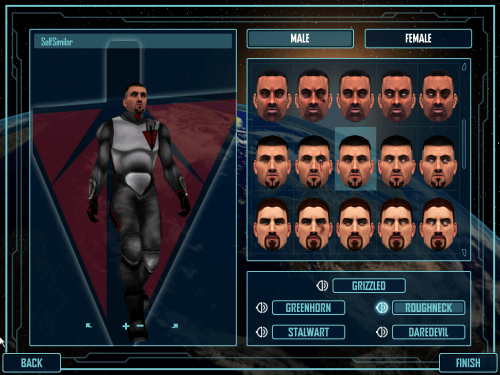
“Creating a new character. Ahhh, these were simpler times…”
In typical MMORPG form, your first steps into Planetside involved picking a server and creating a character. Customization options were limited to picking a gender, a face, and a voice, but the most important thing was selecting a faction. Planetside featured three factions (or “empires”) all fighting for the domination of the planet Auraxis:
- The Terran Republic (TR) represented what was left of Earth’s original occupying force and its remnant government was portrayed as an oppressive militaristic regime. They favored high rate of fire weapons and were identified by a red and black/gray color scheme.
- The New Conglomerate (NC) were a rebel faction fighting for freedom from the Terran Republic’s tyranny. They favored slower but harder hitting weapons and had a particular affinity for shotguns. They were identified by a blue and yellow/gold color scheme.
- The Vanu Sovereignty (VS) were a faction who believed in embracing the technology of the Vanu – the ancient aliens who once inhabited Auraxis. They used energy weapons and “MagLev” hover vehicles. They used a purple and teal/cyan color scheme.
I won’t go any further in talking about the story of Planetside as, let’s face it, it didn’t matter. In real terms, apart from some empire specific weapons and vehicles, there was no practical difference between the three factions. This of course meant that balance issues were limited to only those empire specific items, with everything else being shared between all three groups. The forums were filled with complaints about the NC’s “Jackhammer” and the VS’s “Lasher” (a couple of notable examples) all the same. I originally chose (and stuck with) the New Conglomerate because I liked the idea of being a rebel fighting against an oppressive regime, and I dug their more rugged, sci-fi militarist aesthetic, which was something like the UNSC marines from Halo but rocking a far less practical color scheme. That said, I was always a little jealous of the TR as their faction specific equipment always appealed to me.
Clik here to view.

“Me cheesing the third person camera. Apparently it was working too, judging by the enemy backpack on the ground.”
Once you finished that up there were some basic tutorials to complete. I have to say, the combat itself was fairly bad compared to a lot of its contemporaries in the FPS genre. I never loved the way weapons, especially vehicle weapons, felt. I think for most of us the tradeoff was worth it for Planetside’s uniquely huge battles and open battlefields. Another artifact of its time, there was also an absolutely insane “cone of fire” associated with weapon accuracy. I personally never hated the idea, but I know some people have an extreme dislike for it, and Planetside’s implementation was pretty vicious. There was also a third person view that could be toggled and zoomed in and out, and yes, even outside of vehicles! This mode was garbage for actually playing the game, so it was mostly used for peeking around corners. Since everyone had that ability I never considered it unfair exactly, but definitely open to abuse and could lead to some pretty shitty deaths.
Clik here to view.
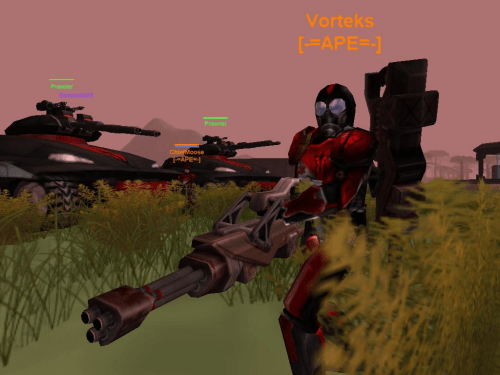
“”Some dirty TR scum hanging around Sanctuary.”
Anyway, at some point you’d find yourself back in your empire’s sanctuary. The sanctuaries were small islands that represented each empire’s headquarters on Auraxis. From there you could access a VR training area where you could try out weapons and vehicles, various terminals to train and equip your character, use the HART (High Altitude Rapid Transport) shuttle to take a drop pod to wherever you’d like on Auraxis, or use a warp gate to warp to another continent. They also seem to have been intended as social hubs to some degree.
Back to your character. There were 20 “battle ranks” (BR) which were levels you progressed through as you gained experience by participating in facility captures, killing enemies, and destroying enemy vehicles and equipment. With each level-up you’d gained certification points (CP or just “certs”) which you could use to spend on a variety of skills or “certifications”. Certifications allowed you to use various equipment – armor, weapons, special devices, and vehicles. How many certification points each certification cost varied, but you could typically unlock some decent equipment by the time you completed the tutorial, and by the time you reached BR 20 you’d have quite a few of them selected. Apart from a few cases of advanced versions of certifications, this wasn’t some complicated tree with prerequisites and branching paths. As you can imagine, this meant that higher level characters had more options than lower level characters, but it didn’t necessarily mean they were any better. It was more of a horizontal progression, in other words. You also had the option of “forgetting” certifications, though only one at a time, and this was on a timer so it was more for correcting mistakes and failed experiments than a total “respec” of your character.
Clik here to view.
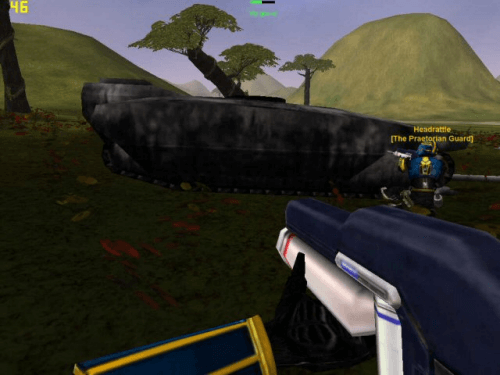
“Using Nano Dispensers to try to save a damaged Vanguard. I think she’s dead, boys!”
A few certifications applied to special equipment, which was more akin to learning a new skill in a traditional RPG:
- Medical Applicator – Allowed the use of a medical applicator, which was a pistol like device that allowed you to heal nearby friendly characters, or yourself. The advanced version of this certification allowed you to revive a dead friendly, which was a particularly powerful ability when playing closely with a squad.
- Engineering – Allowed you to use a Body Armor Nano Kit (BANK) which worked similarly to a Medical Applicator to allow you to repair the armor of a nearby friendly character, or yourself. It also allowed you to use a Nano Dispenser, a larger device which let you repair vehicles, turrets, terminals, and other devices, which was damn handy for vehicle crews to keep in their inventory, by the way.
- Combat Engineering – The advanced version of Engineering was so much more advanced it requires its own section. It made repairs quicker, but it also allowed the player to use an Adaptive Construction Engine (ACE) which let them construct various devices including mines, motion sensors, and automated “Spitfire” turrets. There were limits to how many of each of these you could have deployed at a time, of course.
- Hacking – the normal Remote Electronics Kit (REK) was a pistol-like device that allowed you to hack IFF locked enemy doors and tower and facility control consoles. Pretty much essential for everyone to carry at all times. The hacking cert allowed this device to hack some enemy terminals, and to hack much faster. Advanced Hacking allowed even more types of terminals, notably equipment and vehicle turrets, and even unoccupied enemy vehicles in rare circumstances in which you might come across one. Powerful stuff!
Another subtle but neat thing about battle rank was that your character’s appearance changed as they ranked up through BRs. New Conglomerate troops, for instance, started with blue armor with some minor yellow highlights, and ended up being entirely yellow with some minor blue highlights. It didn’t take too long before almost everyone in my outfit looked the same, of course, but it was a nice touch.
Clik here to view.
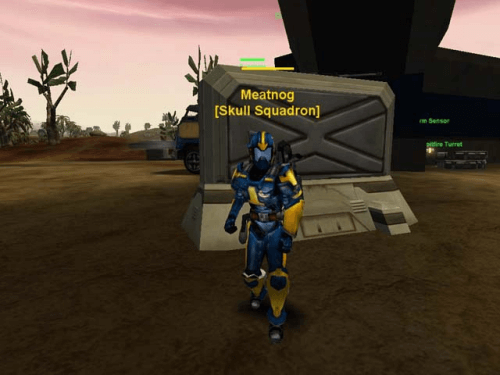
“Meatnog’s blue coloring indicates that he’s below BR7 while his two shinguards and wristguard indicate that he’s CR3.”
There was also “command rank” (CR.) Command rank was leveled up by experience gained as the leader of a squad and each CR would unlock special abilities that could be useful in organizing and participating in large coordinated battles – things the ability to talk in a special command chat channel, place waypoints for your squad on the map, or at later levels, powerful, limited-use abilities like the ability to reveal enemy locations on the map, or order EMP blasts and orbital strikes. As with battle rank, your character’s appearance would be altered slightly with each new command rank gained by having their armor adorned with some additional accessories. Pretty cool stuff.
Clik here to view.
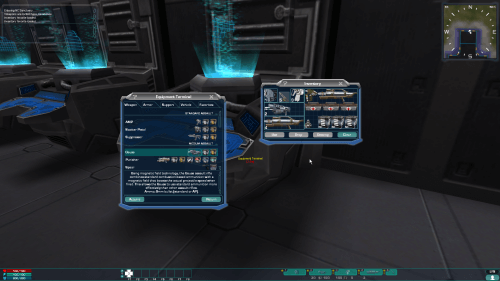
“Using an Equipment Terminal to create a loadout.”
The next and arguably most important thing about your character was your inventory. Planetside featured a full old fashioned, RPG-like grid-based inventory system. You could use your inventory to store additional weapons and ammo and the aforementioned special devices. The amount of inventory varied widely depending on the type of armor you equipped:
- Standard Exo-suit: Your basic starter armor that provided very little protection and a 9 x 6 inventory. No certification required.
- Agile Exo-suit: Light armor that had more protection, a second pistol slot, and a 9 x 9 inventory. This is the armor that was most often used by vehicle pilots but also allowed for faster movement than “Rexo” armor. I rarely used Agile while on foot myself, but did have a loadout which paired it with a “Sweeper” shotgun for speedy CQB assaults.
- Reinforced Exo-suit: Also known as “Rexo” armor. Included yet more armor, a second rifle slot, and a 12 x 9 inventory space, but traded this for a slower movement speed and was restricted from driving in many vehicles. Most infantry used this armor for extra flexibility and protection.
- Infiltration Suit: This suit provided no protection, and only included a single pistol holster and a tiny 6 x 6 inventory. The trade-off was an even faster movement speed than Agile and a unique cloaking ability, however. This obviously lended itself to some very specialized roles and playstyles.
- Mechanized Assault Exo-Suit: “MAX” armor was more like a mini-vehicle than normal armor in some ways. Included built-in weaponry and abilities, a ton of protection, and a huge 16×12 inventory. Like Infiltrators, MAXes played more of a specialized role. I’ll talk about both later on.
Vehicles also had trunks which could be used for additional storage, but the practical uses for these were pretty limited. Likewise, there were storage lockers found at the facilities which were almost exclusively used for looting empire-specific weapons and ammo from fallen enemies and stashing them away to play with on a rainy day. Looting, as a whole, was a fairly unusual addition to the game, honestly.
Finally we had implants. The number of implant slots increased as you leveled up, eventually ending with 3 available slots. Implants granted some special abilities like the ability to run faster, to see cloaked infiltrators, or to hide yourself from enemy radars, for instance. They were typically toggleable rather than always passively enabled, and drained your character’s stamina in addition to requiring activation time after first spawning. While their usage was limited, they were still pretty powerful – the ability to see cloakers with “Darklight Vision” for instance, was fairly invaluable to me.
Clik here to view.

“An NC column consisting of a Sunderer, 4 Vanguards, and a Harasser gather at a warp gate.”
As mentioned, there were a number of vehicles available. You had to have a certification to drive / pilot most of them, and some required additional players to man some of their weapon positions. Most notable of these were the main battle tanks, in which the driver only drove and a second player controlled the main turret weaponry. Ground vehicles included one man ATVs, small armed buggies, a one person tank in addition to those main battle tanks, group transport vehicles, and the all important AMS and ANT vehicles (more on those later.) Air vehicles included a fighter / scout craft, an air to ground attack vehicle, a bomber, a massive troop transport vehicle, and later on, a vehicle transport.
As for putting all of this stuff together, most players would elect to join a squad, whether it was made up of friends or outfit mates or just other random people fighting in the same area. Squads were extremely useful for coordination as you could monitor your squadmates’ locations and status and communicate with text and even a half-decent built-in VoIP implementation, and as an added bonus allowed squad members to share experience points. Infantry squads would usually be made up of mostly soldiers in Rexo armor running whatever combination of certs and gear they preferred. I typically carried NC’s standard Gauss Rifle and a few Decimator dumbfire rocket launchers for the occasional run-in with MAX units (for which they excelled at handling) or vehicles. I’d also carry a Medical Applicator and a BANK for quick self-heals and repairs, along with healing and reviving of squadmates when necessary, and a REK for hacking the doors on enemy controlled structures and, of course, the structures themselves. I’d also pack some medkits for emergency heals and some frag grenades where I could squeeze them in. Oh, and of course, you’d have to account for extra ammo!
Clik here to view.
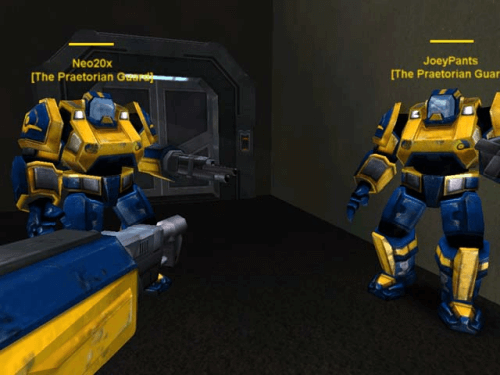
“Me and my fellow NC MAX homies kickin’ it.”
How often MAX units would supplement squads really depended on the individual player – some people loved using MAX armor as much as possible, while others actively avoided it. Still, there were occasional strategies which involved attempting to overpower defenders (or less commonly, out live attackers) by massing MAXes. This was also known as a “MAX crash” due to the tendency for these groups of MAXes to charge into a room or through a chokepoint, as well as the strategy of “dropping” a large number of MAXes on a tower or a facility via a Galaxy dropship. Infiltrators sometimes supplemented a squad too, providing uniquely useful hacking and scouting support. More often than not, Infiltrators preferred to sow the seeds of chaos by playing solo though.
Clik here to view.

“A cloaked NC Infiltrator about to backstab a VS soldier about to gun down an NC soldier about to hack a VS tower’s command console.”
Beyond those, probably the other most specialized infantry role was that of the Combat Engineer. Certain players gravitated hard to this role, and “maining” as a Combat Engineer was indeed a unique playstyle that concentrated on strategically placing, repairing, re-placing, and supplementing deployables like mines and Spitfire turrets, usually in a defensive position. Again, whether or not your squad had anyone playing as an engineer usually came down to personal preference, but I’d often see Combat Engineers playing solo or as part of small special ops squads fighting away from the main battlefronts.
Let’s take a quick step back and talk more about actually getting into the battle.
Planetside allowed you to get from your Sanctuary to the contested lands of Auraxis in a few different ways. First, although there was a timer on its use, “Instant Action” was only a keypress away. This feature would send you plummeting down to the earth in a drop pod to a “hotspot” – a location on the map where combat had recently occurred. Oftentimes this would bring you to one of the larger battles currently in-progress, although occasionally it might bring you to a small fight and maybe one that had already wrapped up. It also made no guarantees about landing you in a safe place, and might even send you into the middle of a battle that your allied empire wasn’t even involved in. This feature was interesting and could be super convenient for new and solo players, but most veteran players rarely used it since it was more desirable to join up with squad and/or outfit mates, or at the very least, strategically pick which fight you wanted to join.
Clik here to view.
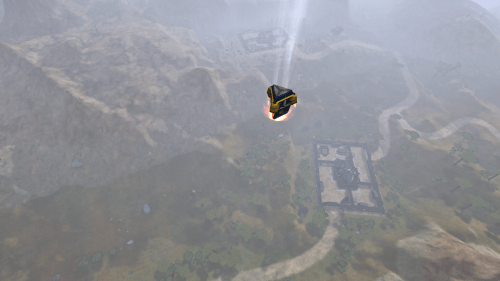
“An NC drop pod plummets down near a facility.”
That’s where taking the HART comes in. As mentioned before, the HART (High Altitude Rapid Transport) shuttle could be taken from the Sanctuary every few minutes and could drop you (again, via drop pod) to almost any location in Auraxis outside of an enemy facility’s sphere of influence and, of course, an enemy empire’s Sanctuary. Despite having to physically go to the shuttle terminal and wait on a timer between flights, it could take you to wherever you wanted to go, quickly and accurately, and was by far the most common way to join the action.
Clik here to view.

“A huge squad of NC Lightning tanks gather at a warp gate.”
Finally, for the more organized players, there were “warp gates” that directly connected the Sanctuaries to specific continents. A player could walk into a warp gate and activate it to teleport to a warp gate on the connected continent. Of course, you wouldn’t want to actually walk – the continents in Planetside were huge and relatively barren. Instead, warp gates were primarily used for transporting coordinated vehicle pushes such as armor columns, air squadrons, or platoons of infantry preparing to drop from multiple Galaxy dropships. Given that they only went to specific places, these would most often be used when attacking directly connected continents since anything else required a lot more travel time – driving or flying from one warp gate to another, although that certainly wasn’t unheard of. In fact, one vehicle, the Lodestar, added late into the first year, seems to have been purpose built with that in mind, allowing you to fly a larger ground vehicle such as an AMS or a main battle tank around as well as serving as a potentially useful battlefield repair station. As an aside, warp gates were also safe zones, which sometimes made for some interesting meet ups with enemy forces. In fact, this was sometimes combined with the looting and advanced hacking systems to facilitate empire-specific weapon and vehicle trades.
In part two I’ll talk more about how the map works and the mechanics of taking it over, and wrap up by talking a bit about about how the game changed.
Pictures taken from my old NC outfit, The Praetorian Guard’s, archived website, JeffBeefjaw’s Imgur album, which looks quite similar, but from the TR perspective, and some newer pictures acquired while playing around on the PSForever server. Unfortunately the two former sources don’t really show any ACTUAL combat, as few people captured full time back in the day so most screenshots were of points of interest, outfit photo ops, and just dicking around rather than normal gameplay.